At least nine people have died as a series of flooding and landslide events hit Jakarta and West Java over the New Year period. Alvico Arif Ardana, 16, died after being electrocuted during a flood in the Kemayoran District of Jakarta on Wednesday 1 January 2020, while in the Cipinang Melayu District three people died of hypothermia after being caught in floods, all are believed to have been elderly. In the city of Depok in West Java four people, including an eight year old child, died in a landslide brought on by heavy rains. Landslides are a common problem after severe weather events, as excess
pore water pressure can overcome cohesion in soil and sediments,
allowing them to flow like liquids. Approximately 90% of all landslides
are caused by heavy rainfall. One person is reported to have died in a flash flood in the city of Bogor, also in West Java. As well as the known fatalities around 19 000 people have been forced to flee homes in the Jakarta area due to flooding.
Flooding in Jakarta on 1 January 2020. AP.
Landslides are a common problem in Java, particularly during the Northeast Monsoon, which lasts from November to February, with peak rainfall in January and February, and can result in an annual
rainfall of around of 4000 mm in parts of Central Java. This problem has been made worse as expanding populations
has led to people farming higher on hillslopes, in an area where soils
tend to be volcanic in action and poorly consolidated (i.e. lack much
cohesion), making them more prone to landslides.
A rescue team evacuating residents of a flooded area of Jakarta on 1 January 2020. Achmad Ibrahim/AP.
Monsoons
are tropical sea breezes triggered by heating of the land during the
warmer part of the year (summer). Both the land and sea are warmed by
the Sun, but the land has a lower ability to absorb heat, radiating it
back so that the air above landmasses becomes significantly warmer than
that over the sea, causing the air above the land to rise and drawing in
water from over the sea; since this has also been warmed it carries a
high evaporated water content, and brings with it heavy rainfall. In the
tropical dry season the situation is reversed, as the air over the land
cools more rapidly with the seasons, leading to warmer air over the
sea, and thus breezes moving from the shore to the sea (where air is
rising more rapidly) and a drying of the climate.
Diagrammatic representation of wind and rainfall patterns in a tropical monsoon climate. Geosciences/University of Arizona.
Java has two distinct Monsoon Seasons, with a Northeast Monsoon driven by winds from the South China Sea that lasts from November to February and a Southwest Monsoon driven by winds from the southern Indian Ocean from March to October. Such a double Monsoon Season is common close to the equator, where the Sun is highest overhead around the equinoxes and lowest on the horizons around the solstices, making the solstices the coolest part of the year and the equinoxes the hottest.
The winds that drive the Northeast and Southwest Monsoons in Southeast Asia. Mynewshub.
Jakarta has become increasingly prone to flooding in recent years, as it is slowly sinking below sealevel. This is largely due to the high rates of water extraction from aquifers beneath the city, to supply water to its 9.6 million residents, which has caused the water-holding sediment layers to deflate, lowering the ground level. In April 2019 the Indonesian Government announced that it planned to move the country's capitol to another location, probably a custom-built city on Borneo, due to concerns about the long-term habitability of Jakarta, which is threatened both by subsidence and rising sea levels associated with global warming, as well as pollution and overcrowding caused by the rapid rate at which the city has expanded.
See also...
Follow Sciency Thoughts on Facebook.










